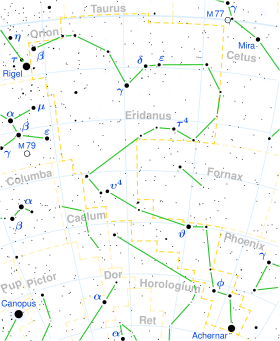Eta Eridani
Eta Eridani (η Eridani, abbreviated Eta Eri, η Eri), officially named Azha (with a silent 'h', possibly /ˈeɪzə/),[8][7] is a giant star in the constellation of Eridanus. Based on parallax measurements taken during the Hipparcos mission, it is approximately 137 light-years from the Sun.
 | |
| Observation data Epoch J2000.0 Equinox J2000.0 | |
|---|---|
| Constellation | Eridanus |
| Right ascension | 02h 56m 25.64948s[1] |
| Declination | −08° 53′ 53.3221″[1] |
| Apparent magnitude (V) | +3.87[2] |
| Characteristics | |
| Spectral type | K1+ IIIb[3] |
| U−B color index | _0.98[2] |
| B−V color index | +1.12[2] |
| Variable type | suspected[4] |
| Astrometry | |
| Radial velocity (Rv) | −20.32 km/s |
| Proper motion (μ) | RA: +77.36 ± 0.19[1] mas/yr Dec.: −220.16 ± 0.20[1] mas/yr |
| Parallax (π) | 23.89 ± 0.19[1] mas |
| Distance | 137 ± 1 ly (41.9 ± 0.3 pc) |
| Absolute magnitude (MV) | +0.83[5] |
| Details | |
| Mass | 1.43[6] M☉ |
| Radius | 10.48[6] R☉ |
| Luminosity | 57.5[6] L☉ |
| Surface gravity (log g) | +2.79[6] cgs |
| Temperature | 4,742[6] K |
| Rotational velocity (v sin i) | 2.34[6] km/s |
| Age | 2.66[6] Gyr |
| Other designations | |
| Database references | |
| SIMBAD | data |
Nomenclature
η Eridani (Latinised to Eta Eridani) is the star's Bayer designation.
It bore the traditional name Azha, from the old Arab asterism نَعَام أُدْحِيّ udḥiyy al-naʽām "the ostrich nest" (or "hatching place"), which included Eta Eridani.[9] The first word, ادحى udḥiyy, was miscopied as ازحى (readable as azḥā) in medieval manuscripts.[8] In 2016, the International Astronomical Union organized a Working Group on Star Names (WGSN)[10] to catalogue and standardize proper names for stars. The WGSN approved the name Azha for this star on 12 September 2016 and it is now so included in the List of IAU-approved Star Names.[7]
In Chinese, 天苑 (Tiān Yuàn), meaning Celestial Meadows, refers to an asterism consisting of Eta Eridani, Gamma Eridani, Pi Eridani, Delta Eridani, Epsilon Eridani, Zeta Eridani, Pi Ceti, Tau1 Eridani, Tau2 Eridani, Tau3 Eridani, Tau4 Eridani, Tau5 Eridani, Tau6 Eridani, Tau7 Eridani, Tau8 Eridani and Tau9 Eridani.[11] Consequently, the Chinese name for Eta Eridani itself is 天苑六 (Tiān Yuàn liù, English: the Sixth Star of Celestial Meadows).[12]
Properties
η Eridani belongs to spectral class K3 and has a giant luminosity class. It is an evolved star that has expanded to tens times the size of the sun and nearly sixty times its luminosity. It is red clump giant, a star slightly more massive than the sun which is currently fusing helium in its core.[13] This is a mild barium star, sometimes referred to a "semi-barium" star. Although most barium stars are in binary systems, η Eridani has no known companion.[14]
η Eridani is a high proper motion star, a relatively close star that is moving across the sky at a high rate compared to most stars.[15] It is suspected to be a variable star with a range from magnitude 3.81 to 3.90.[4]
References
- Van Leeuwen, F. (2007). "Validation of the new Hipparcos reduction". Astronomy and Astrophysics. 474 (2): 653. arXiv:0708.1752. Bibcode:2007A&A...474..653V. doi:10.1051/0004-6361:20078357.
- Ducati, J. R. (2002). "VizieR Online Data Catalog: Catalogue of Stellar Photometry in Johnson's 11-color system". CDS/ADC Collection of Electronic Catalogues. 2237: 0. Bibcode:2002yCat.2237....0D.
- Keenan, Philip C.; McNeil, Raymond C. (1989). "The Perkins catalog of revised MK types for the cooler stars". Astrophysical Journal Supplement Series. 71: 245. Bibcode:1989ApJS...71..245K. doi:10.1086/191373.
- Samus, N. N.; Durlevich, O. V.; et al. (2009). "VizieR Online Data Catalog: General Catalogue of Variable Stars (Samus+ 2007-2013)". VizieR On-line Data Catalog: B/gcvs. Originally Published in: 2009yCat....102025S. 1. Bibcode:2009yCat....102025S.
- Da Silva, L.; Girardi, L.; Pasquini, L.; Setiawan, J.; von Der Lühe, O.; De Medeiros, J. R.; Hatzes, A.; Döllinger, M. P.; Weiss, A. (2006). "Basic physical parameters of a selected sample of evolved stars". Astronomy and Astrophysics. 458 (2): 609. arXiv:astro-ph/0608160. Bibcode:2006A&A...458..609D. doi:10.1051/0004-6361:20065105.
- Jofré, E.; Petrucci, R.; Saffe, C.; Saker, L.; de la Villarmois, E. Artur; Chavero, C.; Gómez, M.; Mauas, P. J. D. (2015). "Stellar parameters and chemical abundances of 223 evolved stars with and without planets". Astronomy & Astrophysics. 574: A50. arXiv:1410.6422. Bibcode:2015A&A...574A..50J. doi:10.1051/0004-6361/201424474.
- "Naming Stars". IAU.org. Retrieved 16 December 2017.
- Davis, George A. (1944). "The pronunciations, derivations, and meanings of a selected list of star names". Popular Astronomy. 52: 8–30.
- Kunitzsch, Paul; Smart, Tim (2006). A Dictionary of Modern star Names: A Short Guide to 254 Star Names and Their Derivations (2nd rev. ed.). Cambridge, Massachusetts: Sky Pub. ISBN 978-1-931559-44-7.
- IAU Working Group on Star Names (WGSN), International Astronomical Union, retrieved 22 May 2016.
- (in Chinese) 中國星座神話, written by 陳久金. Published by 台灣書房出版有限公司, 2005, ISBN 978-986-7332-25-7.
- (in Chinese) 香港太空館 - 研究資源 - 亮星中英對照表 Archived August 11, 2010, at the Wayback Machine, Hong Kong Space Museum. Accessed on line November 23, 2010.
- Laney, C. D.; Joner, M. D.; Pietrzyński, G. (2012). "A new Large Magellanic Cloud K-band distance from precision measurements of nearby red clump stars". Monthly Notices of the Royal Astronomical Society. 419 (2): 1637. arXiv:1109.4800. Bibcode:2012MNRAS.419.1637L. doi:10.1111/j.1365-2966.2011.19826.x.
- Lu, Phillip K. (1991). "Taxonomy of barium stars". Astronomical Journal. 101: 2229. Bibcode:1991AJ....101.2229L. doi:10.1086/115845.
- Gontcharov, G. A.; Andronova, A. A.; Titov, O. A.; Kornilov, E. V. (2001). "The proper motions of fundamental stars. I. 1535 stars from the Basic FK5". Astronomy and Astrophysics. 365 (2): 222. Bibcode:2001A&A...365..222G. doi:10.1051/0004-6361:20000010.